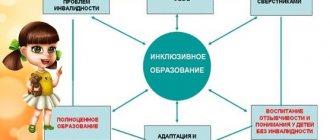Conversation with children of the preparatory group “About the benefits of vitamins, and why do people need them?”
Nadezhda Oliferova
Conversation with children of the preparatory group “About the benefits of vitamins, and why do people need them?”
Good day, dear Maamites! I've been away for so long, but now new material has appeared and I'm here. I hasten to share with you a conversation with preschoolers about the benefits of vitamins, and why do people need them? The topic is important and useful!
Goal: to give children knowledge about the benefits of vitamins for our body. Introduce the concept of “vitamins A, B, C, D, E” and the products that contain them. To consolidate children's knowledge about the need for vitamins in the human body, about the benefits of foods that contain vitamins.
Material: pictures of food for the game “Where are you, vitamin?”, baskets of fruits and vegetables.
Educator: - Guys, today we will talk about the benefits of vitamins and the healthiest foods. Do you know what the healthiest foods are? (vegetables, berries, fruits)
Why are vegetables and fruits so beneficial?
(they contain a lot of vitamins)
That's right!
What do you think, at what time of year do we get the most vitamins? (Summer, autumn)
Absolutely right! In autumn there is a large harvest of vegetables and fruits.
All vegetables and fruits contain a lot of useful substances. When we eat them, our body receives a large supply of vitamins so that we are healthy and do not get sick.
If we do not receive vitamins, then even the healthiest person will begin to weaken, his teeth will begin to deteriorate, his hair will begin to fall out and his eyesight will deteriorate. He will always feel tired and will start to get sick more often. A person needs all vitamins without exception. But each vitamin also has its own direct purpose.
All vitamins are divided into groups A, B, C, D, E. Do you want to know what healthy foods belong to them?
And so, the first vitamin A was called the growth vitamin, but its role in the body is limited to more than just that. Lack of vitamin A causes eye disease. This disease manifests itself in the fact that a person who sees well during the day sees poorly at dusk, and in the dark almost completely loses vision. Also, due to a lack of vitamin A, our skin loses its elasticity and becomes rough. What foods contain the most of this vitamin?
First of all, vitamin A is found in butter, egg yolk, milk, and fish. Also in vegetables and fruits: carrots, onions, pumpkin, spinach, lettuce, tomatoes and apricots.
The second vitamin B - with a lack of this vitamin, a person’s ability to work is impaired, and digestion is also disrupted. We get tired quickly and cannot concentrate on important matters. What foods will help us? These are rye and wheat bread, oatmeal, buckwheat and barley porridge. There is a lot of vitamin B in meat.
Fizminutka
"Glutton"
One pot-bellied big guy (Round movement with both hands around the stomach)
Ate a dozen rolls on an empty stomach (Put all your fingers in front of you)
He washed down the rolls with milk , (Make an imaginary glass with your fingers and then drink from it)
Ate the chicken in one piece. (Spread the fingers of one hand wide, palm up, bring an imaginary piece to your mouth)
Then he roasted the lamb (Show the horns with your index fingers)
And directed it into the belly of the poor (Stroke the belly)
The big guy swelled up like a ball (Draw a large circle in the air)
The glutton had a blow here. (Lightly hit the forehead with your palm)
The third is vitamin C - it promotes the consumption of oxygen by the cells of our body. If there is not enough vitamin C in food, then the body's resistance to infectious diseases decreases, drowsiness appears, pain appears when brushing teeth, and gums bleed. Vitamin C is found in fresh vegetables, berries and fruits. It is especially abundant in green onions, black currants, and rose hips. In fresh and sour cabbage, tomatoes, radishes and turnips, potatoes. There is a lot of vitamin C in lemons and oranges.
The fourth vitamin D - if this vitamin is not enough, the human body will become poorly absorbed calcium and phosphorus, the bones will become weak, soften and bend. Vitamin D is found in foods such as: fish, liver, butter, egg yolk, milk. Vitamin D is also found in the rays of the sun, which means we need to spend more time in the air and get the vitamin through ultraviolet rays.
And finally, the fifth vitamin E is anti-aging. Due to the lack of this vitamin, there is a lack of coordination of movements, rapid fatigue, lethargy, vision deteriorates, and the person looks pale and sickly. What foods contain vitamin E? Vegetable oil, nuts, milk and dairy products, lettuce and parsley, beans, rosehip tomatoes, white cabbage.
Vitamins are substances that our body needs to absorb food, they increase performance, resistance to infectious diseases, and promote the growth of our body.
Now, let's play the game “Where are you, vitamin?” and find out how you remember which foods belong to which vitamins. ( The game is played on the carpet. The teacher shows or names a vitamin, children choose which foods form this vitamin).
Game “Where are you, vitamin?”
Educator: - Guys, what new did we learn today? What vitamins did you get acquainted with, name them (A, B, C, D, E)
. What are vitamins for? How do we get them?
Well done! You remembered everything perfectly!
Literature:
“Baby Nutrition” is a book about how to properly feed a child in order to raise him healthy and strong. Moscow 1958
Content:
- Children's vitamins: what are they and does your child need them?
- Vitamins for children: features of choice
- The best vitamins for children: rating For babies under one year old
- For 1-3 years
- For preschoolers over 3 years old
- For younger students
- For teenagers
- At what age should a child be given vitamins?
Types of immunity
Immunity includes humoral and cellular immunity. Let's look at each of them in more detail. Humoral is ensured by the presence of antibodies (substances that bind to antigens) in the blood. Cellular is provided by cells of the immune system. Immunity can be congenital or acquired. In turn, the acquired one can be active or passive. Active develops after illness, for example, ARVI. It also forms after vaccination. Passive is formed when ready-made antibodies are transfused into the body in the form of serum. It also develops when antibodies are passed from a mother's milk to her newborn baby. In fact, natural immunity includes congenital immunity, acquired after an illness, as well as passive immunity during the transfer of antibodies from mother to baby. Artificial immunity is called immunity after the introduction of a vaccine or serum with antibodies.
Immune organs
After we have examined the concept of immunity and its main types, it is necessary to pay attention to the organs that provide it.
There are central and peripheral organs of the immune system.
The central ones include:
- Red bone marrow. Found in bones. Serves as a source of formation of all blood cells, including cells of the immune system.
- Thymus. It further matures some of the immune system cells coming from the red bone marrow.
Peripheral organs:
- Lymph nodes.
- Spleen.
- Accumulations of lymphoid cells in the skin, respiratory organs, and intestines.
Popular questions from parents about children's vitamins
Questions about vitamins that parents ask especially often:
At what age should a child be given vitamins?
Vitamins in the form of drops can be given to a baby from the first days of life as prescribed by a doctor.
Is the natural composition of vitamins important?
It is desirable that the composition of the chosen product be as natural as possible. In the middle price category, semi-synthetic vitamins predominate - they are well absorbed and rarely provoke allergies. The body absorbs completely natural vitamins perfectly, but such preparations are expensive and difficult to find on sale. Fully synthetic drugs have a low price, but they are absorbed by the body for a long time.
Does my child need to take vitamin and mineral complexes on a regular basis?
No, it is enough to take vitamins in a course according to the instructions for the drug, no more than two courses a year. It is best to take vitamins during the off-season periods: spring and autumn.
What vitamins are especially important for a child's development?
Most often, children have a deficiency of vitamins C and group B - it is desirable that these vitamins be part of the chosen product. Vitamins A, D, E can be obtained in sufficient quantities by simply adjusting the child’s diet.
Vitamin A
If the child is often sick, gets tired even after light exertion; if he has a lag in growth and physical strength in comparison with his peers, as well as problems with the digestive system, blurred vision (especially in the dark), problems with skin and hair. Vitamin A will be an effective helper in solving these problems.
Vitamin A helps improve metabolism, gain muscle mass and achieve normal growth characteristic of a certain age - which is why it is called the vitamin for child growth. In addition, it has a beneficial effect on the immune system, increasing the resistance of the child’s body to viral colds, and in the case of an existing cold, it allows it to be more easily and comfortably tolerated. In addition, this vitamin has a positive effect on vision, the condition of the skin, hair, nails, and makes wound healing easier and faster. Compatibility. In vitamin complexes, vitamin A combines well with vitamins C and E and Zinc, while vitamin A itself helps absorb iron, which is important for the child’s body.
Hypervitaminosis and its symptoms
Hypervitaminosis is a condition of the body that occurs as a result of the ingestion of an ultra-high dose of one or more vitamins. The source of the latter can be both food products and vitamin preparations. Symptoms of hypervitaminosis vary depending on the vitamin, the amount of which significantly exceeds the norm.
| A type of hypervitaminosis | Symptoms of hypervitaminosis |
| Hypervitaminosis a | Peeling of the skin, itching, hair loss, increased excitability, headaches, nausea and vomiting, joint pain. |
| Hypervitaminosis d | Lethargy, drowsiness, headaches, pain in joints, bones, muscles, stomach, itching, thirst, nausea, vomiting, weight loss. |
| Hypervitaminosis e | Weakness, headaches and muscle pain, diarrhea, possible seizures. |
| Hypervitaminosis c | Insomnia, headaches, feeling hot, dizziness, itching, rash, damage to tooth enamel, high blood pressure, loose stools. |
B vitamins
The key role of these vitamins is to ensure energy metabolism - the conversion of useful substances received by the child into energy, and this is what ensures the vital functions of our body. Also, vitamins of this group ensure normal functioning of the nervous system, increase resistance to stress, and improve the functioning of the digestive system.
For children, a lack of B vitamins in the body is usually indicated by symptoms such as poor appetite, apathy or, conversely, increased excitability and irritability, as well as insomnia. It should be noted that for normal growth and development, a child needs vitamins in a much higher dosage than an adult.
Compatibility. B vitamins are well compatible with each other, but the combination of B1 with B6 and B12 is not permissible.
The best vitamins for children: rating
The best vitamins are not just supplements, but drugs that will really help solve health problems and will not harm the child. This is why it is important to choose the best products from well-known manufacturers: they are more likely to be useful and safe (for example, they will not provoke an allergic reaction) than vitamins from unknown brands.
The table below shows the rating of vitamins for children of different ages:
Read more about the best vitamins for children (prices are indicative).
For babies under one year old:
Aquadetrim
Image: aquadetrim.com.
This is an aqueous solution of vitamin D3, adapted specifically for children under one year old. Designed for the prevention of rickets. Due to the fact that the drug is dissolved in a water base, Aquadetrim is instantly absorbed into the baby’s intestines, which helps to avoid colic and other digestive problems.
Advantages of the drug:
- strengthens the nervous and immune system;
- replenishes vitamin D3 deficiency.
Flaws:
- According to some parents, it is inconvenient to use the drug dispenser;
- If used incorrectly, an overdose or side effects may occur (nausea, vomiting, constipation, colic, weakness and disturbances in appetite and sleep).
Price : 200 rubles.
Multi-Tabs Baby
The vitamins are suitable for children under one year of age: they have no side effects, and thanks to their neutral taste, children take the product without any whims. They contain vitamins A and C, and D in small quantities (if you live in a region where there is little sun, you will most likely have to take additional vitamin D).
Advantages of the drug:
- strengthens the immune system;
- has a positive effect on the condition of bones, teeth and skin;
- small dosage and ease of administration (both during meals and before use);
- excellent tolerability and minimum contraindications.
Flaws:
- The bottle can only be stored in the refrigerator; after opening, the drug is good for only 2 months.
Price: 350 rubles.
Liquid Vitamin C ChildLife
American single-component vitamins with ascorbic acid are intended for children over 6 months. Vitamin C is necessary for children to strengthen the immune system and, according to parents, after taking dietary supplements, children actually get sick much less often.
Advantages of the drug:
- pleasant orange taste;
- natural composition;
- economical consumption.
Flaws:
- quite high price;
- an allergic reaction is possible.
Price: 850 rubles.
For 1-3 years:
Solgar Kangavites
A vitamin and mineral complex from the USA with a well-thought-out composition: with this remedy there will definitely be no vitamin deficiency in children. One tablet of Solgar Kangavites contains the daily requirement of vitamins and microelements necessary for a child. The drug is available in the form of chewable tablets.
Advantages of the drug:
- natural composition;
- completely satisfies the body’s need for nutrients;
- large volume - 120 tablets per package.
Flaws:
- high price;
- The child may not like the fact that the chewable tablet is chewed with little effort.
Price: 1000 rubles.
Alphabet Our Baby
One sachet of popular Russian vitamins contains up to 50% of the nutrients necessary for a child - a total of 11 vitamins and 5 minerals. The drug is one of the few of its kind - created on the principles of separate and joint intake of vitamins and minerals, due to which allergies are practically eliminated, and the beneficial substances themselves are absorbed better and faster.
Advantages of the drug:
- good composition;
- helps improve appetite;
- strengthens the immune system;
- has a beneficial effect on the nervous system and mental development of the baby;
- hypoallergenic;
- low calorie content;
- does not require swallowing.
Flaws:
- The contents of the sachet should be dissolved in water and taken three times a day.
Price: 500 rubles.
Syrup Pikovit
The syrup contains useful substances important for the child’s health: vitamin A, D3, C, B vitamins. It is especially suitable for nutritional disorders: poor appetite or an insufficiently varied diet.
Advantages of the drug:
- According to reviews, Pikovit really helps a child improve appetite and cope with increased fatigue;
- tastes good.
Flaws:
- a pleasant taste is achieved due to the dyes and flavors in the composition.
Price: 500 rubles.
For preschoolers over 3 years old:
Supradin Kids
Dragees contain a full range of nutrients for a growing, active child. The composition includes vitamins responsible for good vision, strengthening the immune system, and normal functioning of the nervous system. The complex is supplemented with iodine and zinc - important elements for the proper physical development of a preschooler.
Advantages of the drug:
- Children like the taste;
- good composition;
- quickly restores existing deficits;
- eye protection and general strengthening of the immune system;
- convenient regimen.
Flaws:
- contains quite a lot of sugar.
Price: 550 rubles.
Alphabet Kindergarten
Multi-colored chewable tablets with, as the manufacturer himself indicates, a competent combination of components. Alphabet Kindergarten contains vitamins and minerals necessary for the physical and mental development of a preschooler: A, E, C, group B, magnesium, calcium, zinc.
The process of taking vitamins is also interesting for children - each tablet has its own taste and color. Take the drug three times a day: morning, lunch and evening with food.
Advantages of the drug:
- promotes growth and physical development;
- improves memory;
- the tablets taste good;
- does not contain artificial colors or preservatives.
Flaws:
- You need to take the product three times a day, which is not always convenient.
Price: 300 rubles.
VitrumKids Plus
Designed to replenish the nutrients necessary for the child: they contain 12 vitamins and 10 minerals. The content of vitamins A and D in the preparation is especially high - they are enough to fully satisfy the child’s body’s need for these vitamins.
Chewable tablets come in the shape of funny teddy bears and, despite the not very pleasant taste, children willingly take the toy-like tablets.
Advantages of the drug:
- variety of vitamins and minerals;
- regular use has a good effect on the formation of teeth, strengthening the immune system, and the normal functioning of the nervous system;
- The tablets have an interesting shape for the child and are easy to chew;
- especially relevant during periods of intensive growth;
- does not need to be washed down with water or swallowed;
- compensates for most of the necessary substances for the child’s body;
- One pack is enough for one course.
Flaws:
- not very pleasant to the taste, contain dyes and flavors. Low content of vitamin C. If the dosage is violated, an allergic reaction is possible.
Price: 500 rubles.
For younger students:
Alphabet Schoolboy
The complex, containing 11 vitamins and 7 minerals, is designed to make it easier for students to cope with mental and emotional stress.
The drug is taken three times a day - each tablet performs its own function: some tablets replenish iron deficiency, others contribute to the full development of the student, and others strengthen bones and teeth.
Advantages of the drug:
- high efficiency due to separate administration of tablets;
- good composition.
Flaws:
- contains dyes and flavors;
- One package is not enough for a full course.
Price: 350 rubles.
Univit Kids with Omega-3 and Choline
The high content of B vitamins makes the drug an excellent assistant in adapting to new conditions. Lozenges in the shape of dolphins can improve memory and increase a child’s performance.
Advantages of the drug:
- has a good effect on the nervous system and mental development;
- attractive shape for children;
- reliable manufacturer (Germany);
- strengthening the immune system.
Flaws:
- not very pleasant taste;
- tablets are harsh:
- contraindicated in diabetes.
Price: 600 rubles.
Doppelhertz Kinder
Chewable lozenges with useful substances that schoolchildren need: 10 vitamins, zinc, choline and iodine. Designed for the full physical and intellectual development of the student.
Advantages of the drug:
- good composition;
- suitable for children with excess weight or diabetes due to the absence of artificial additives and low energy value;
- high efficiency and quick results.
Flaws:
- cannot always be found in pharmacies.
Price: 500 rubles.
For teenagers:
Complivit Active
Fruit-flavored dragees are created specifically to support health during increased mental and physical stress. It contains 12 vitamins and 10 minerals that help improve vision, normalize the functioning of the nervous system, strengthen bone tissue, and cleanse the skin.
Advantages of the drug:
- thoughtful composition;
- compensates for the deficiency of nutrients due to an unbalanced diet;
- simple form of administration and affordable price.
Flaws:
- artificial colors in the composition.
Price: 200 rubles.
Pikovit Forte
The tablets contain B vitamins, vitamins A, C, D and E. They work comprehensively: they help a teenager get rid of fatigue, stimulate mental activity, support immunity and reduce anxiety typical of adolescence.
Advantages of the drug:
- significantly improves the emotional and physical state of a senior student, even with active sports;
- take only 1 time per day.
Flaws:
- contains artificial flavors;
- takes a long time to dissolve.
Price: 380 rubles.
Multi-Tabs Junior
Chewable tablets with a variety of fruity and sweet flavors contain the most essential substances for a rapidly growing body. They help eliminate the negative consequences of poor nutrition and successfully cope with a high academic load.
Advantages of the drug:
- high efficiency;
- pleasant taste.
Flaws:
- artificial flavoring additives in the composition.
Price: 350 rubles.







